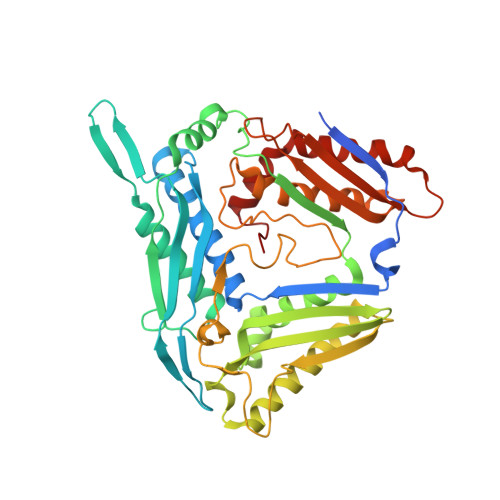Visible-Light Removable Photocaging Groups Accepted by MjMAT Variant: Structural Basis and Compatibility with DNA and RNA Methyltransferases.
Peters, A., Herrmann, E., Cornelissen, N.V., Klocker, N., Kummel, D., Rentmeister, A.(2022) Chembiochem 23: e202100437-e202100437
- PubMed: 34606675
- DOI: https://doi.org/10.1002/cbic.202100437
- Primary Citation of Related Structures:
7P82, 7P83, 7P84, 7P8M - PubMed Abstract:
Methylation and demethylation of DNA, RNA and proteins constitutes a major regulatory mechanism in epigenetic processes. Investigations would benefit from the ability to install photo-cleavable groups at methyltransferase target sites that block interactions with reader proteins until removed by non-damaging light in the visible spectrum. Engineered methionine adenosyltransferases (MATs) have been exploited in cascade reactions with methyltransferases (MTases) to modify biomolecules with non-natural groups, including first evidence for accepting photo-cleavable groups. We show that an engineered MAT from Methanocaldococcus jannaschii (PC-MjMAT) is 308-fold more efficient at converting ortho-nitrobenzyl-(ONB)-homocysteine than the wildtype enzyme. PC-MjMAT is active over a broad range of temperatures and compatible with MTases from mesophilic organisms. We solved the crystal structures of wildtype and PC-MjMAT in complex with AdoONB and a red-shifted derivative thereof. These structures reveal that aromatic stacking interactions within the ligands are key to accommodating the photocaging groups in PC-MjMAT. The enlargement of the binding pocket eliminates steric clashes to enable AdoMet analogue binding. Importantly, PC-MjMAT exhibits remarkable activity on methionine analogues with red-shifted ONB-derivatives enabling photo-deprotection of modified DNA by visible light.
Organizational Affiliation:
Department of Chemistry and Pharmacy, Institute of Biochemistry, University of Münster, Corrensstr. 36, 48149, Münster, Germany.














